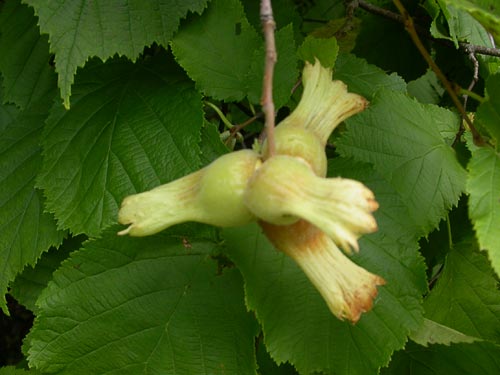Relatives
Corylus avellana L. - European filbert.
Taxonomic position.
Family: Betulaceae C.F.Gray; genus: Corylus L.Morphology and biology.
Perennial shrub. Young branches are grey, bare. One-year-old branches are yellowish grey, covered with hairs or bristles and glandules. Buds are rounded or ovate, slightly compressed, with naked or finely pubescent squamae, ciliate along the edge. Leaves on the leafstalk are 1-2 cm long, rounded or oval, anisocordate at the base and acerated at the tip, irregularly bidentate, bare, but pubescent along the veins. Leaf blade is 6-12 cm long and 5-9 cm wide, with 6-12 veins, darker from above. Petioles are covered with bristles and glandules. Stipules are oblong-ovate with an obtuse tip, pilose. Antheral aments are up to 5 cm long; squamae are densely pubescent; anthers are bare, with a tuft of hair on top. Fruit are acervate, (1)2-5 fruits per cluster. Fruit involucre is bell-shaped, open, consisting of two inciso-dentate leaflets with broad laminae, nearly equal in length to the nut. Nut is oval or almost spherical in shape. Blossoms in February-April; bears fruit in September. Wind-pollinated. Zoochore. Capable of vigorous distribution as coppice.Distribution.
Scandinavia (except the northern part), Central Europe, Atlantic Europe, the Mediterranean, the Balkans, and Asia Minor. Within the former USSR, species occurs in the European region (the Ladoga-Ilmen region, far southwestern areas of the Dvina-Pechora region, Upper- and Middle-Dnieper, Upper-Volga, Volga-Kama, Trans-Volga, Volga-Don, Near-Black-Sea and Crimean regions), and the Caucasus (Ante-Caucasus, Daghestan, Western, Southern and Eastern Transcaucasia, and the Talysh region).Ecology.
Occurs in light, mixed and broad-leaved forests as brushwood, often in clearings.Utilization and economic value.
Nut-bearing plant, used for food. Local population in different areas traditionally consumes fruit of wild filbert as delicacy (roasted nut kernels). Wild filbert is the progenitor of several dozens of large-fruited hazelnut varieties grown on an industrial scale. Such forms as pendula, quercifolia, laciniata, aurea and atropurpurea generate ornamental varieties. Oil from its fruit is one of the highest in quality among vegetable oils. Branches are used to manufacture wicker furniture, pipe shanks, walking sticks and hoops. It is undoubtedly possible to advance large-fruited filbert varieties into more northern areas.References:
Bush N.A., ed. 1939. Flora USSR. Vol. V. M.-L.: Publishing House of Acad. Science, pp. 264-265. (in Russian).Cherepanov, S.K. 1995. Plantae Vasculares Rossicae et Civitatum Collimitanearum (in limicis USSR olim). St-Petersburg, "Mir I Semia", 990 p. (in Russian).
Grossgheim, A.A. 1945. Flora of Caucasus. Vol. III. Baku: Publishing House of Azerbaijan Acad. Science, appendix.
Hulten E., Fries M. 1986. Atlas of north European vascular plants north of the Tropic of Cancer. Konigstein. V. 1-3. 1172 p.
Moscow State University [MWG], Moscow, Russia.
Mosel, H. 1965. Vergleichende Chorologie der Zentraleuropischen Flora. Jena, 583 s.
N.I. Vavilov Institute [WIR], Saint Petersburg, Russia.
Tsvelev, N.N. 2000. Manual of the vascular plants of Russia (Leningrad, Pskov and Novgorod district). St. Petersburg, Publishing House of SPHFA, p. 356 (in Russian).
V.L. Komarov Botanical Institute [LE], Saint Petersburg, Russia.


